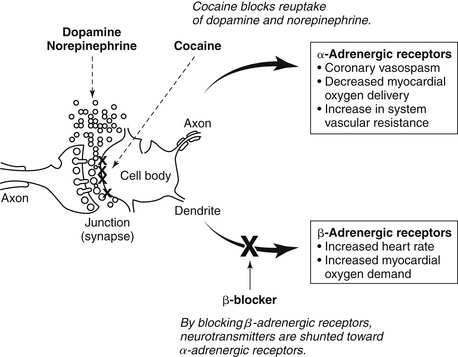Chapter 49
Cocaine and the Heart
1. How common is cocaine use in the United States?
2. What are the pharmacologic effects of cocaine?
Cocaine is a powerful sympathomimetic that acts by directly stimulating central sympathetic outflow and blocking presynaptic uptake of norepinephrine and dopamine (Fig. 49-1). This augmentation in postsynaptic catecholamines increases heart rate, mean arterial pressure, and left-ventricular contractility through stimulation of both α- and β-adrenergic receptors. Through enhanced α-adrenergic receptor activation, increased endothelin production, and diminished nitric oxide generation, cocaine initiates coronary artery vasoconstriction. Cocaine may also enhance platelet aggregation and thrombus formation through heightened production of adenosine diphosphate, thromboxane A2, and tissue plasminogen activator inhibitors, as well as reductions in protein C and antithrombin III. Cocaine causes toxic effects on cardiac muscle that arise primarily from Ca2+ overload during excessive β-adrenergic stimulation. Cocaine is well absorbed through all body mucous membranes and can be administered by nasal, sublingual, intramuscular, intravenous, and respiratory routes. The onset of action varies from 3 seconds to 5 minutes, depending on the administration route.

Figure 49-1 Proposed potential mechanism of the cardiovascular effects of cocaine when β-blockers are administered in cocaine-induced acute coronary syndrome.
3. What are the typical symptoms after cocaine ingestion?
4. What are the consequences of cocaine use?
5. How often does AMI occur after cocaine ingestion?
6. What else should be considered in the differential diagnosis after cocaine use?



